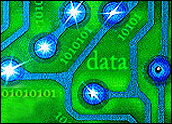
SanDisk on Thursday took the latest swing in its memory match against Samsung with the introduction of a 32 GB, 1.8-inch solid state drive drop-in replacement for the standard mechanical hard disk drive.
SanDisk’s latest NAND flash-based SSD counters Samsung’s Wednesday announcement that promised 16 GB memory and advanced 50-nanometer process technology.
SanDisk and Samsung are battling for coveted NAND flash memory technology placements in a laptop computer market that posted 29 percent growth in 2006, according to the research firm DisplaySearch.
Bragging on NAND
“Once we begin shipping the 32 GB SSD for notebook PCs, we expect to see its increasing adoption in the coming years as we continue to reduce the cost of flash memory,” said Eli Harari, SanDisk CEO.
When SSD devices become more affordable, Harari expects the drives’ advantages over rotating disk drives will create a new consumer category for the company’s retail sales channels worldwide. The NAND flash memory, for example, would allow a user to walk around with a laptop without affecting the drive’s performance.
SanDisk said its SSD offers an extremely low power consumption rate compared to a hard disk drive. This is particularly important to extend the battery life for the benefit of enterprise road warriors, the company explained.
SanDisk relies on its patented TrueFFS flash management technology to enhance its NAND-based SSDs. The drive has no moving parts and does not need to spin into action or seek files the way conventional hard disk drives do, which boosts performance, the company noted.
A Costly Alternative
SanDisk is aiming its new product at enterprise users on its road map toward mass consumer adoption. The declining cost of NAND flash memory has made SSD a viable alternative for mobile PCs, the company noted.
The technology was previously limited to the military, aerospace and telecom industries that demanded high performance and reliability, regardless of price.
“It is projected that inclusion of the SanDisk 32 GB SSD in a notebook PC could increase the end user price by around $600 in the first half of 2007,” Harari added.
SanDisk is betting that enterprise users may be willing to pay more for the advantages NAND flash has to offer. However, mainstream adoption of NAND flash-based mobile computers is not imminent, according to TrendFocus analyst John Donovan.
“Even if you give it six to nine months and SanDisk is able to make multiple millions of these and pull the price down to a comparable cost, you are still going against 120 GB drives on the notebook side,” Donovan told TechNewsWorld. “This is definitely something to watch, but it’s a long way down the road.”
Portable Solutions
SanDisk’s SSD may see faster adoption in smaller portable devices like MP3 players. Indeed, there has been a huge increase in demand for NAND flash memory over the past few years from consumer devices such as digital cameras, MP3 players and mobile phones, according to Robert Gray, an analyst with IDC.
“There are dramatically higher bit capacities and lower prices, so the technology is now well positioned to be the foundation for new generations of potentially disruptive solid state drives. Enterprise mobile PC users will find the high performance and low power consumption especially attractive,” Gray noted.




















































